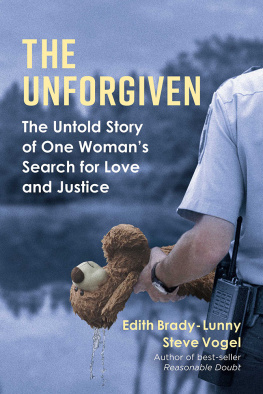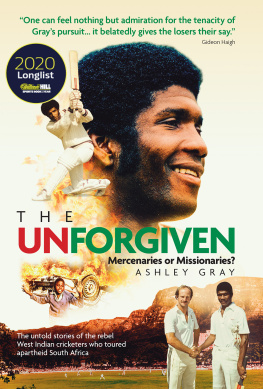Preface
Our society demands we place responsibility where it belongs, insisting on accountability and consequences for errant acts. Yet our culture also embraces forgiveness, as thorny and complicated as it may be.
This is a true story of guilt, of grief, and pain for lives lost, of a reckoning for mistakes that can never be reversed. Its the story about a woman whose life, littered with years of abuse and her own misguided attempts to capture love she desperately craved, took an ugly turn on a single evening and then a despairing path through the halls of justice.
The story spirals full circle in an unforeseen, even bewildering way, confronting you with gnawing questions about fairness and quality of justice, about victims unable to speak for themselves, about the well-being of the most vulnerable, about whether society has been well or poorly served.
Co-author Edith Brady-Lunny is a reporter who witnessed much, if not most, of whats described here. Actual trial transcripts and police recordings are used, edited only for brevity and clarity.
I can forgive, but I cannot forget
is only another way of saying,
I cannot forgive.
Henry Ward Beecher
Chapter One

S ave my babies! Oh my God!
Amanda Hamm was hysterical, jumping up and down, pointing to the water, screaming her aching plea to the first emergency worker to arrive after her frantic 911 call.
The tall woman with wavy chestnut hair was being held in check by her boyfriend, Maurice LaGrone Jr., his arms wrapped around Amandas waist. Now he turned her around, forcing her head into his shoulder, trying to prevent her from seeing the desperate scene about to unfold some 70 yards from where they stood.
DeWitt County Sheriffs Department Sergeant Timothy Collins looked toward the waters of Clinton Lake. A vehicle was submerged, not far from a boat ramp. Tail lightsnot what he would expectreflected through the water. Usually it was headlights youd see when a car or truck, on a slippery ramp, was dragged backwards into the water by an attached boat trailer. This green 1997 Oldsmobile Cutlass had gone into the lake front-end firstnot backwards. The hood of the four-door car dipped downward in seven feet of water. The vehicles rear portion was closer to the shore, resting in water just over four feet deep.
As other rescuers began to arrive, Collins quickly turned to what brought him and the others to the lake at breakneck speedssaving children trapped inside the submerged car.
He removed his gun belt and ran into the water, noticing part of the cars antenna was above the water. The lake was calm but so murky that when he dove under water, he could see nothing. Collins felt his way along to a door handle on the vehicles passenger side. He opened the front door with little effort. But the weight of his wet uniform and bullet-proof vest pulled him down. He swam, then waded back to shore where he removed the vest.
Meanwhile a second deputy replaced Collins at the front passenger door. Reaching through the inky water, his hands felt an infant car seat. It was empty. He grabbed it and pushed it behind him. His next desperate reach produced a little girl, not much more than an infant, floating face down in the front portion of the car. He flipped the toddler onto her back and pushed her over to Collins who rushed her to paramedics waiting on the boat ramp.
So began the hand-to-hand relay between first responders who used every ounce of instinct and training to save the children.
A Clinton ambulance pulled into the parking lot with two emergency medical technicians on board. One of them waded into the water and took a second child, a young boy, maybe 50 pounds, from a deputy and hurried him to a partner.
The second EMT performed mouth-to-mouth resuscitation on the boy as she helped carry him from the lake. Once inside the ambulance, the unconscious child vomited frequently, making it difficult to force air into his lungs through an oxygen mask placed on his face. The rescuer did chest compressions, paused to check for a pulse that wasnt returning and screamed for help when the little girl was delivered to the back of the ambulance. Two firefighters responded and immediately applied to the girl the same life-saving maneuvers being used on her brother.
Back in the lake, an EMT was pulling still another boy, younger, from his floating posture in the rear of the car. The boys feet had been snagged in the tentacles of a seat belt. The emergency responder rushed him to shore, lay him on the ground and began CPR outside the ambulance hectic with activity aimed at saving the boys brother and sister.
Watching the drama unfold from a fishing boat was Darren Leggett. The timing of his trip back to shore after an evening on the lake had put him in the midst of the turmoil. A womans screams of my kids are dead had competed with the grumble of his boats motor. Setting aside initial hesitancy to become involved with what looked like a domestic situation between a bi-racial couple, Leggett had moved his boat closer to see what he could do. Thats when the first police unit arrived.
Leggett relayed to officers the meager but crucial information he had gleaned from the couple: There were three kids in the car. Now it was obvious to him that the two boys and little girl were all in extreme distress.
As the sun set on the surreal scene, Maurice consoled Amanda, continuing to hold her back from the ambulance and the commotion as the first, second, then third child was pulled from Clinton Lake. They remained near the pay phone they had used to summon help in the parking lot within clear view of the lake.
A Clinton firefighter was behind the wheel of the ambulance as it pulled out for the sprint to Clintons hospital with six-year-old Christopher, 23-month-old Kyleigh and four rescuers on board. The desperate labor to save the youngsters would continue for all of the five-minute ride.
With a second ambulance not yet at the scene, rescue workers decided to transport three-year-old Austin in the rear of the fire department vehicle. One EMT continued life-saving efforts in the back of the SUV as another firefighter hurried them to the hospital.
It had taken first responders less than two minutes after they arrived to get the kids out of the submerged car. But it was hard to tell how long the children had been in the water. Their small bodies appeared lifeless.
Deputy Bruce Randolph directed Amanda and Maurice into the back seat of his patrol car for the high-speed ride to the hospital.
Is there somebody we can call? he asked as the police vehicle tore down Route 10, lights and siren going.
I cant breathe, Amanda gasped. She was wet and cold. Do you think my kids will be okay?
Maurice held her. Sweet Jesus, he said. Let these kids be all right.
Randolph was determined to get Amanda to the hospital as quickly as possible in case there were questions she needed to answer for the medical staff. But his haste seemed to add to Maurices anxiety. Several times he asked the officer to slow down from his speed of 100 mph.
Chapter Two

D r. David Gill was in the middle of his routine emergency room shift at Clintons Dr. John Warner Hospital when he heard a police radio dispatch about a multi-victim accident. Additional doctors and nurses were immediately summoned to beef up the small hospitals skeletal medical staff supervised by a single physician.











